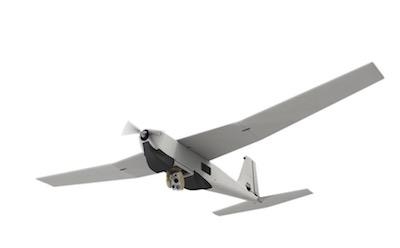Mon, Mar 12, 2018
Customer Is A 'Major Country In The Middle East'
A "major country" in the Middle East has awarded a contract valued at $44.5 million to AeroVironment for Puma II AE small UAS featuring the new Mantis i45 sensor.

“This contract for the ground forces of a Middle East regional power, and our largest international order to date, reflects AeroVironment’s continually growing international customer base and our ongoing commitment to equipping more allied forces with the innovative UAS solutions needed to ensure successful missions in a wide range of operations,” said Kirk Flittie, vice president and general manager of AeroVironment’s Unmanned Aircraft Systems business segment.
Puma AE UAS equipped with the Mantis i45 sensor suite enables operators to see better and farther than ever before, providing more actionable intelligence so users can proceed with certainty. Capable of ground and water landings, the rugged, portable and fully waterproof Puma AE gives operators unmatched operational flexibility in the small UAS class.
The onboard Mantis i45 electro-optical/infrared (EO/IR) gimbal sensor suite is a powerful, versatile and high-value tool that delivers dramatically improved imaging capabilities to give military users world-class ISR capabilities comparable to platforms many times the size and cost of Puma AE. In operations, the Mantis i45 reduces the likelihood of detection by increasing the distance between the Puma AE and areas of interest while still providing the clarity and image quality of a close-range asset. Its high-resolution imagery also aids in target analysis, positive identification and enables operators to identify threats to friendly forces more effectively. By minimizing Puma’s exposure to detection by the enemy, the Mantis i45 greatly improves its ability to complete reconnaissance missions safely and effectively.
Puma AE’s enhanced precision navigation system with secondary GPS provides optimal positional accuracy and reliability. Moreover, AeroVironment’s common ground control system (GCS) allows the operator to control the aircraft manually or program it for GPS-based autonomous navigation.
“AeroVironment’s small UAS are transforming the way U.S. and allied ground forces around the world plan, train, equip and operate – giving them the tools needed to proceed with certainty in the most challenging circumstances,” said Flittie.
(Image provided with AeroVironment news release)
More News
A Puff Of Smoke Came Out From The Top Of The Engine Cowling Followed By A Total Loss Of Engine Power On May 9, 2025, about 1020 mountain daylight time, an experimental amateur-buil>[...]
From 2022 (YouTube Edition): Jenny, I’ve Got Your Number... Among the magnificent antique aircraft on display at EAA’s AirVenture 2022 was a 1918 Curtiss Jenny painstak>[...]
Very High Frequency (VHF) The frequency band between 30 and 300 MHz. Portions of this band, 108 to 118 MHz, are used for certain NAVAIDs; 118 to 136 MHz are used for civil air/grou>[...]
“From approximately November 2021 through January 2022, Britton-Harr, acting on behalf of AeroVanti, entered into lease-purchase agreements for five Piaggio-manufactured airc>[...]
Microburst A small downburst with outbursts of damaging winds extending 2.5 miles or less. In spite of its small horizontal scale, an intense microburst could induce wind speeds as>[...]
 NTSB Prelim: Lee Aviation LLC JA30 SuperStol
NTSB Prelim: Lee Aviation LLC JA30 SuperStol Classic Aero-TV: Curtiss Jenny Build Wows AirVenture Crowds
Classic Aero-TV: Curtiss Jenny Build Wows AirVenture Crowds ANN's Daily Aero-Term (05.30.25): Very High Frequency (VHF)
ANN's Daily Aero-Term (05.30.25): Very High Frequency (VHF) Aero-News: Quote of the Day (05.30.25)
Aero-News: Quote of the Day (05.30.25) ANN's Daily Aero-Term (05.31.25): Microburst
ANN's Daily Aero-Term (05.31.25): Microburst



